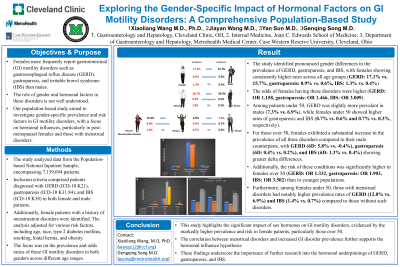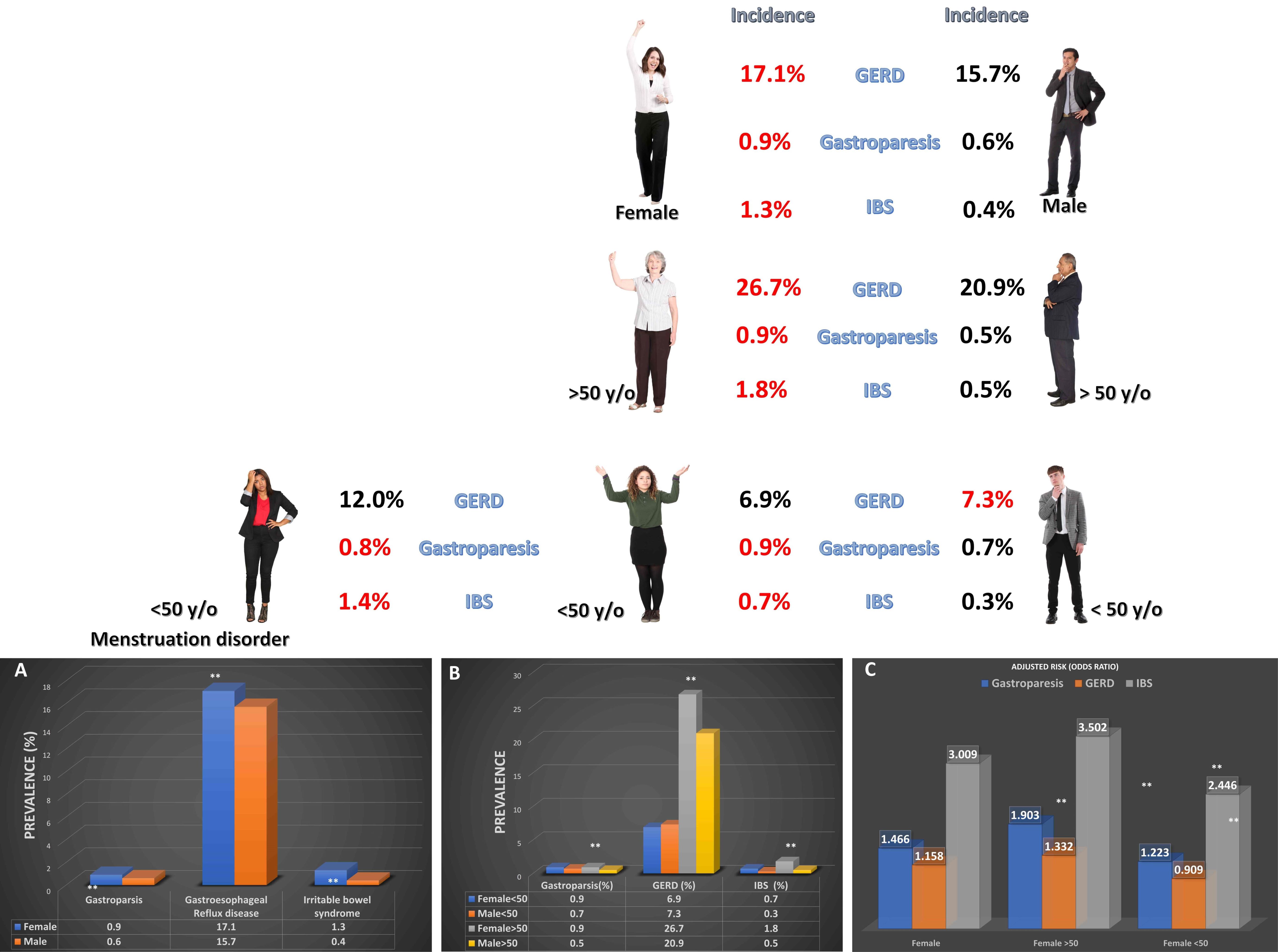Monday Poster Session
Category: Functional Bowel Disease
P2347 - Exploring the Gender-Specific Impact of Hormonal Factors on GI Motility Disorders: A Comprehensive Population-Based Study
Monday, October 28, 2024
10:30 AM - 4:00 PM ET
Location: Exhibit Hall E

Has Audio

Xiaoliang Wang, MD, PhD
Digestive Disease and Surgery Institute, Cleveland Clinic
Cleveland, OH
Presenting Author(s)
Xiaoliang Wang, MD, PhD1, Jiayan Wang, MD, PhD2, Yan Sun, MD3, Gengqing Song, MD4
1Digestive Disease and Surgery Institute, Cleveland Clinic, Cleveland, OH; 2Joan C. Edwards School of Medicine, Marshall University, Huntington, WV; 3Case Western Reserve University / MetroHealth, Cleveland, OH; 4MetroHealth, Cleveland, OH
Introduction: Females more frequently report GI motility disorders like GERD, gastroparesis, and IBS than males. The role of gender and hormonal factors in these disorders is not well understood. Our study aimed to investigate gender-specific prevalence and risk factors in GI motility disorders, focusing on hormonal influences, particularly in post-menopausal females and those with menstrual disorders.
Methods: The study analyzed data from the NIS including 7,159,694 patients. Inclusion criteria comprised patients diagnosed with GERD, gastroparesis, and IBS in both genders. Additionally, female patients with a history of menstruation disorders were identified. The analysis adjusted for various risk factors such as age, race, type 2 diabetes, smoking, hiatal hernia, and obesity. The focus was on the prevalence and odds ratios of these GI motility disorders across different age ranges for both genders.
Results: The study identified pronounced gender differences in the prevalence of GERD, gastroparesis, and IBS, with females showing consistently higher rates across all age groups (GERD: 17.1% vs. 15.7%, gastroparesis: 0.9% vs. 0.6%, IBS: 1.3% vs. 0.4%; p< 0.01). The odds of females having these disorders were higher (GERD: 1.158, gastroparesis: 1.466, IBS: 3.009). Among patients under 50, GERD was slightly more prevalent in males (7.3% vs. 6.9%), while females under 50 showed higher rates of gastroparesis and IBS (0.7% vs. 0.6% and 0.7% vs. 0.3%, respectively). In contrast, for those over 50, females exhibited a substantial increase in the prevalence of all three disorders compared to their male counterparts, with GERD (δD: 5.8% vs. -0.4%), gastroparesis (δD: 0.4% vs. 0.2%), and IBS (δD: 1.3% vs. 0.4%) showing greater delta differences. Additionally, the risk of these conditions was significantly higher in females over 50 (GERD: OR 1.332, gastroparesis: OR 1.903, IBS: OR 3.502) than in younger populations. Furthermore, among females under 50, those with menstrual disorders had notably higher prevalence rates of GERD (12.0% vs. 6.9%) and IBS (1.4% vs. 0.7%) compared to those without such disorders.
Discussion: This study highlights the impact of sex hormones on GI motility disorders, evidenced by the higher prevalence and risk in female patients, especially those over 50. The link between menstrual disorders and increased GI disorder prevalence supports the hormonal influence hypothesis. These findings emphasize the need for further research into the hormonal underpinnings of GERD, gastroparesis, and IBS.

Disclosures:
Xiaoliang Wang, MD, PhD1, Jiayan Wang, MD, PhD2, Yan Sun, MD3, Gengqing Song, MD4. P2347 - Exploring the Gender-Specific Impact of Hormonal Factors on GI Motility Disorders: A Comprehensive Population-Based Study, ACG 2024 Annual Scientific Meeting Abstracts. Philadelphia, PA: American College of Gastroenterology.
1Digestive Disease and Surgery Institute, Cleveland Clinic, Cleveland, OH; 2Joan C. Edwards School of Medicine, Marshall University, Huntington, WV; 3Case Western Reserve University / MetroHealth, Cleveland, OH; 4MetroHealth, Cleveland, OH
Introduction: Females more frequently report GI motility disorders like GERD, gastroparesis, and IBS than males. The role of gender and hormonal factors in these disorders is not well understood. Our study aimed to investigate gender-specific prevalence and risk factors in GI motility disorders, focusing on hormonal influences, particularly in post-menopausal females and those with menstrual disorders.
Methods: The study analyzed data from the NIS including 7,159,694 patients. Inclusion criteria comprised patients diagnosed with GERD, gastroparesis, and IBS in both genders. Additionally, female patients with a history of menstruation disorders were identified. The analysis adjusted for various risk factors such as age, race, type 2 diabetes, smoking, hiatal hernia, and obesity. The focus was on the prevalence and odds ratios of these GI motility disorders across different age ranges for both genders.
Results: The study identified pronounced gender differences in the prevalence of GERD, gastroparesis, and IBS, with females showing consistently higher rates across all age groups (GERD: 17.1% vs. 15.7%, gastroparesis: 0.9% vs. 0.6%, IBS: 1.3% vs. 0.4%; p< 0.01). The odds of females having these disorders were higher (GERD: 1.158, gastroparesis: 1.466, IBS: 3.009). Among patients under 50, GERD was slightly more prevalent in males (7.3% vs. 6.9%), while females under 50 showed higher rates of gastroparesis and IBS (0.7% vs. 0.6% and 0.7% vs. 0.3%, respectively). In contrast, for those over 50, females exhibited a substantial increase in the prevalence of all three disorders compared to their male counterparts, with GERD (δD: 5.8% vs. -0.4%), gastroparesis (δD: 0.4% vs. 0.2%), and IBS (δD: 1.3% vs. 0.4%) showing greater delta differences. Additionally, the risk of these conditions was significantly higher in females over 50 (GERD: OR 1.332, gastroparesis: OR 1.903, IBS: OR 3.502) than in younger populations. Furthermore, among females under 50, those with menstrual disorders had notably higher prevalence rates of GERD (12.0% vs. 6.9%) and IBS (1.4% vs. 0.7%) compared to those without such disorders.
Discussion: This study highlights the impact of sex hormones on GI motility disorders, evidenced by the higher prevalence and risk in female patients, especially those over 50. The link between menstrual disorders and increased GI disorder prevalence supports the hormonal influence hypothesis. These findings emphasize the need for further research into the hormonal underpinnings of GERD, gastroparesis, and IBS.

Figure: Prevalence and odds ratios of GI motility disorders by gender. Upper: Prevalence of GERD, gastroparesis, and IBS in females and males at all ages, >50, <50, and in women <50 with menstrual disorders. Lower: A, bar graph of prevalence of GERD, gastroparesis, and IBS by gender. B, bar graph of prevalence by age group. C, adjusted odds ratios of GERD, gastroparesis, and IBS by gender and age group.
Disclosures:
Xiaoliang Wang indicated no relevant financial relationships.
Jiayan Wang indicated no relevant financial relationships.
Yan Sun indicated no relevant financial relationships.
Gengqing Song indicated no relevant financial relationships.
Xiaoliang Wang, MD, PhD1, Jiayan Wang, MD, PhD2, Yan Sun, MD3, Gengqing Song, MD4. P2347 - Exploring the Gender-Specific Impact of Hormonal Factors on GI Motility Disorders: A Comprehensive Population-Based Study, ACG 2024 Annual Scientific Meeting Abstracts. Philadelphia, PA: American College of Gastroenterology.
